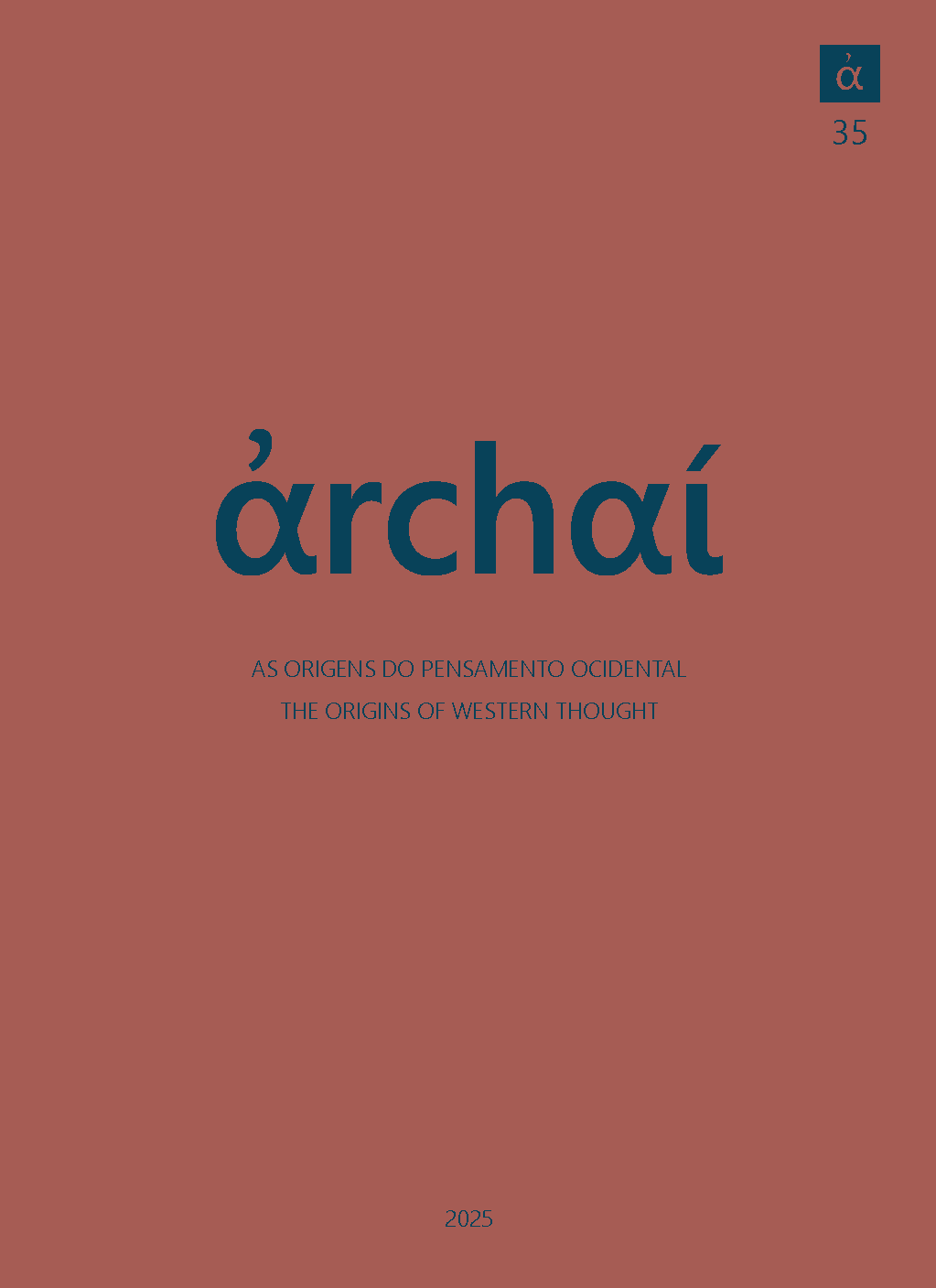Soul as Explanatory Cause of Life in Aristotle: Scientific Knowledge simpliciter (ἁπλῶς) through Coextensive Universal Demonstrations and Context Restriction as a Solution to a Core-Dependent Homonymy from DA II.1-4
DOI:
https://doi.org/10.14195/1984-249X_35_03Palavras-chave:
Aristotle, explanation, homonymy, soulResumo
The main purpose of this paper is to show, based on Aristotle’s theory of scientific demonstration, how soul plays the role of explanatory cause of life in De Anima (DA) II.1-4. Firstly, I evaluate how, in APo I.2 and II.16, Aristotle requires that universal demonstrations must satisfy a coextensional criterion between a given explanandum (A-term) and its most appropriate explanans (B-term), and that this criterion does not entail a causal symmetry between both those terms. I argue, following Angioni (2014a) and Zuppolini (2018), that, whenever one is before apparent ‘multiple causes’ scenario cases, in which there seems to be more than one possible cause to the same explanandum, one shall still find a unified and fully appropriate explanation of that explanandum. In the second part of this paper, I examine an example from DA II.1-4 in light of APo II.16-17. I argue that soul might be pointed out as the explanatory principle (B) that explains why life (A) belongs to a living body (C). In addition to that, I argue that, although there is a core-dependent homonymy taking place between plants (γ1), animals (γ2) and the nutritive capacity (α1), the nutritive soul (β1) plays the role of an incidental factor (συμβεβηκός) in the context of a scientific demonstration that has by explananda whatsoever attributes (αn) that belong to animals (γ2) qua living beings endowed with a perceptive soul (β1) that explains why attributes (αn) belong to them.
Downloads
Referências
ACKRILL, J. L. (ed.) (1963). Aristotle’s Categories and De interpretatione Oxford, Oxford University Press.
ACKRILL, J. L. (1981). Aristotle’s Theory of Definition: some questions on Posterior Analytics II 8-10. In: BERTI, E. Aristotle on Science: The Posterior Analytics, Proceedings of the Eighth Symposium Aristotelicum Padova, Editrice Antenore, p. 359-384. Also In: ACKRILL, J. Essays on Plato and Aristotle Oxford, Clarendon Press, p. 110- 130.
ANGIONI, L. (2007). O conhecimento científico no livro I dos Segundos Analíticos de Aristóteles. Journal of Ancient Philosophy 1, n. 2, p. 1-24.
ANGIONI, L. (2012). Os seis requisitos das premissas da demonstração científica em Aristóteles (Segundos Analíticos I 2). Manuscrito 35, p. 7-60.
ANGIONI, L. (2014a). Aristotle on Necessary Principles and on Explaining X Through the Essence of X. Studia Philosophica Estonica 7, n. 2, p. 88-112.
ANGIONI, L. (2014b). Demonstração, silogismo e causalidade. In: ANGIONI, L. (ed.). Lógica e Ciência em Aristóteles Campinas, Editora PHI, p. 61-120.
ANGIONI, L. (2016). Aristotle’s Definition of Scientific Knowledge (APo 71b 9-12). Logical Analysis and History of Philosophy 19, p. 79-105.
ANGIONI, L. (2018). Causality and Coextensiveness in Aristotle’s Posterior Analytics 1.13. Oxford Studies in Ancient Philosophy 54, p. 159-185
ANGIONI, L. (2019). What Really Characterizes Explananda: Prior Analytics, I, 30. Eirene. Studia Graeca et Latina 55, p. 147-177.
ANGIONI, L. (2020). Aristóteles e a necessidade do conhecimento científico. Discurso 50, n.2, p. 193-238.
BARNES, J. (ed.) (1993). Posterior Analytics Oxford, Oxford University Press .
BIEHL, G. (ed.) (1884). Aristotelis. De Anima libri III Lipsiae, Teubner.
BOLTON, R. (1976). Essentialism and Semantic Theory in Aristotle: Posterior Analytics, II, 7-10. The Philosophical Review 85, no. 4, p. 514-544.
BRONSTEIN, D. (2016). Aristotle on Knowledge and Learning: The Posterior Analytics Oxford, Oxford University Press .
BURNYEAT, M.F. (1981). Aristotle on Understanding Knowledge. In: BERTI, E.(ed.). Aristotle on Science- The Posterior Analytics Padova, Editrice Antenore , p. 97-140.
CHARLES, D. (2000). Aristotle on Meaning and Essence Oxford, Clarendon Press.
FEREJOHN, M. (2013). Formal Causes: Definition, Explanation, and Primacy in Socratic and Aristotelian Thought Oxford, Oxford University Press .
FINE, G. (2010). Aristotle’s Two Worlds: Knowledge and Belief in Posterior Analytics 1.33. Proceedings of the Aristotelian Society 110, p. 323-46.
HASPER, P. (2006). Sources of Delusion in Analytica Posteriora 1.5. Phronesis 51, p. 252-284.
LENNOX, J. G. (1987). Divide and Explain: The Posterior Analytics in Practice. In: GOTTHELF, A.; Lennox, J. G. (eds.). Philosophical Issues in Aristotle’s Biology Cambridge, Cambridge University Press, p. 90-119.
ROSS, W. D. (ed.) (1949). Aristotle’s Prior Analytics and Posterior Analytics Oxford, Oxford University Press .
SHIELDS, C. (1999). Order in Multiplicity. Homonymy in the Philosophy of Aristotle Oxford, Clarendon Press .
ZUPPOLINI, B. A. (2018). Explanation and Essence in Posterior Analytics II 16-17. Revista Archai 24, p. 229-264.
Downloads
Publicado
Como Citar
Edição
Seção
Licença
Copyright (c) 2025 Ahmad Suhail Farhat

Este trabalho está licenciado sob uma licença Creative Commons Attribution 4.0 International License.
Dado o acesso público desta revista, os textos são de uso gratuito, com obrigatoriedade de reconhecimento da autoria original e da publicação inicial nesta revista. O conteúdo das publicações é de total e exclusiva responsabilidade dos autores.
1. Os autores autorizam a publicação do artigo na revista.
2. Os autores garantem que a contribuição é original, responsabilizando-se inteiramente por seu conteúdo em caso de eventual impugnação por parte de terceiros.
3. Os autores garantem que a contribuição que não está em processo de avaliação em outras revistas.
4. Os autores mantêm os direitos autorais e concedem à revista o direito de primeira publicação, sendo o trabalho licenciado sob a Creative Commons Attribution License-BY.
5. Os autores têm permissão e são estimulados a publicar e distribuir seu trabalho on-line após a publicação na revista.
6. Os autores dos trabalhos aprovados autorizam a revista a, após a publicação, ceder seu conteúdo para reprodução em indexadores de conteúdo, bibliotecas virtuais e similares.
7. É reservado aos editores o direito de proceder ajustes textuais e de adequação do artigo às normas da publicação.














